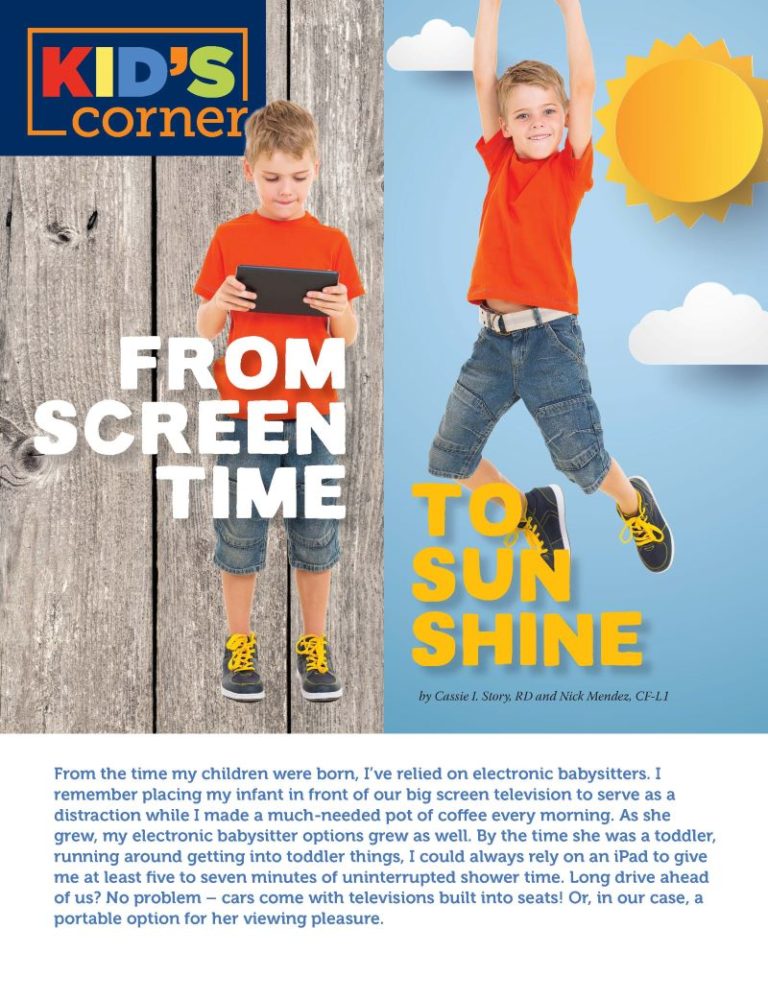From Screen Time to Sunshine


by Cassie I. Story, RD and Nick Mendez, CF-L1
Spring 2018
From the time my children were born, I’ve relied on electronic babysitters. I remember placing my infant in front of our big screen television to serve as a distraction while I made a much-needed pot of coffee every morning. As she grew, my electronic babysitter options grew as well. By the time she was a toddler, running around getting into toddler things, I could always rely on an iPad to give me at least five to seven minutes of uninterrupted shower time. Long drive ahead of us? No problem – cars come with televisions built into seats! Or, in our case, a portable option for her viewing pleasure.
There is no doubt that our current societal norm is to plop our children in front of a screen as soon as possible. And who can blame us? Between work obligations, cooking and the housework that goes into managing a family, what other options do we have?
I recall being in my pediatrician’s office and seeing the American Academy of Pediatrics’ (AAP) recommendations for child media use. One of the recommendations was for children less than two years of age to have zero screen time, at which I laughed. For additional AAP recommendations, please see below.
In what world could that be possible? Was the AAP going to provide a nanny and chef for me? Those recommendations have been echoing in the back of my mind for years, though I never heeded much thought to actually following the advice.
Well, my first child is now 11 years old, and as life would have it, I now belong to a beautiful blended family of five young ladies. Their ages range from nine to 14, and true to form, they are all unique individuals with different interests and needs. Our household can be loud, fun, dramatic, chaotic, disorganized and loud (yes, I know I stated that already). One of the most frequent offenders to the volume in our home comes from screens.
The other day, as I was in the kitchen, I noticed something. One child (whose name will remain anonymous to protect the innocent) was performing an act I’d never seen before and wouldn’t have imagined was possible. She had not one, not two, but three screens in front of her at the same time. She was sitting on the couch binge watching a show on Netflix, while playing a YouTube clip from one of her favorite YouTube stars and texting.
It made me pause and think. Do we need to finally abide by the screen time rules? Do those rules need to be expanded to include no more than one screen at a time? Where will this end? Later that day, Nick and I discussed my screen time concerns and decided to make some changes.
Health and wellness are important to both of us, as I am a dietitian and he has a background in personal training and coaching. We talked to the girls about mindfulness – about being present each moment of every day and the importance of doing one thing at a time. We also went beyond this and had a discussion about increasing our activity levels as a family.
We had a family meeting and came up with some ideas to put down our screens (we are just as guilty of it as they are) and get outside! We placed a chart on our fridge and started tracking our screen time as well as outside time. We came up with a list of ideas of things to do outside as a family, or individually. Nick even designed a fun circuit workout we could do at the park together (See page 42). Each member of the family set their own personal goal for limiting screens and changing habits.
What I’ve found that works best for us is making a game out of things. It adds an element of fun to any task we are trying to accomplish. Here are some other ideas from the WeCan® (Ways to Enhance Children’s Activity & Nutrition) program which is a collaboration between the National Heart, Lung, and Blood Institute (NHLBI), the National Institute of Diabetes and Digestive and Kidney Diseases (NIDDK), the Eunice Kennedy Shriver National Institute of Child Health and Human Development (NICHD) and the National Cancer Institute (NCI) – all aimed to help improve the health of children and families in the Unites States.
Here are some of their ideas:
- Log Screen Time vs. Active Time – By logging a weeks’ worth of screen time and active time, you will have a better understanding of how much time is being spent on each activity. Then, you can make changes according to your goals.
- Make Screen Time Active Time – During commercial breaks, perform some type of physical movement. You can write down ideas on index cards and place them in a bucket or bowl to keep near the television. Every time a commercial comes on, pull out one of the cards and perform the activity listed. Samples include squats, lunges, push-ups, stretching, balancing on one leg, jumping jacks, etc.
- Create Screen-free Bedrooms – Research has shown that children who have televisions in their bedroom watch an average of 90 minutes more of it per day than those who do not.
- Provide Other Options – Have a list of activities ready to go in plain sight for your children. When they ask if they can have screen time (and you’ve decided it’s not time for that), point to the list and have them choose another activity instead. Ideas include going on a scooter ride, going on a rock hunt outside, playing with playdoh, etc.
- Understand Television Ads – Unfortunately, commercial ads affect all of us. When we see snacks or beverages on the television, it turns on signals in our brain that stimulate appetite or the desire to eat. Combine this with targeted ads to children by having a cartoon or sports character acting as a mascot, and you can have a strong desire to want whatever product is being advertised. Out of sight, out of mind can be true for many things, including the drive to eat. Limiting commercial viewing may help with decreasing the desire to snack in front of the television.
If you would like additional resources including free print-outs of screen time charts, parent tips and handbooks and many other beneficial tools, please visit:
www.nhlbi.nih.gov/health/educational/wecan/tools-resources/tools-reduce-screen-time.htm
Here are Some Other Thoughts to Consider:
What is Screen Time?
This is a term used for activities done in front of a screen, including: watching television, working on a computer, playing a video game or playing on a smart phone or tablet.
What’s the Big Deal about Screen Time?
Screen time increases sedentary time. This means that when you sit in front of a screen, you are physically inactive. For children and adults, this can contribute to poorer health. Too much screen time has also been linked to:
- Poor sleeping habits
- Raising the risk for attention problems
- Anxiety
- Depression
- Increased risk for obesity
Family Workout
by Nick Mendez, CF-L1
Taking the whole family outside offers us quality time away from digital distractions. The nearby park provides endless opportunities for outdoor activities and creative workouts. It’s hard not to have fun when you combine sunshine, high fives and exercise, right? Bring a watch or smartphone to use as a timer for this 15-minute workout:
Station 1 – Lower body
Spend one minute doing as many repetitions as possible of your favorite leg exercise. Options include stepping up to the seat of a park bench, then back down with alternating legs; doing lunges in the grass to a depth your knees allow; or simply sitting down on the park bench and then standing back up quickly. Maintain safe positions at all times while giving yourself a personal challenge for one minute. Then switch to the next station.
Station 2 – Upper body
Spend one minute doing as many repetitions as possible of your favorite chest movement. One option is the push-up, which you can do in the traditional position on the sidewalk if strength allows. Or adjust to your comfort level by placing your hands (a) on the seat of a park bench or (b) against a wall while standing a couple feet away. Putting your body in a more vertical position allows you to adjust the push-up resistance to your comfort level.
Station 3 – Move
Spend two minutes simply moving your body. This could be a run around the park, a brisk walk to the light pole and back or a scooter ride around the basketball court. Let each family member be creative.
Rest for one minute, and then repeat these three stations for a total of three rounds.
Current Screen Time Statistics:
Research estimates that children ages eight to 18 spend the following amount of time on screens each day:
- 7.5 hours using entertainment media
- 4.5 hours watching television
- 1.5 hours on the computer
- > 1 hour playing video games
- < 25 minutes reading a book
Ways to Decrease Screen Time:
- Remove televisions from the bedroom
- Do not allow television-watching during meal time or homework
- Do not allow children to eat while watching television or using the computer (this encourages mindless eating which can lead to consuming more food than needed)
- Do not leave the television on for background noise; play the radio instead
- Be a good role model; decrease all family members’ screen time to two hours or less
per day - Create a family challenge (make it a game!): See if you can go one day or one week without watching television
About the Authors:
Cassie I. Story, RD, is a registered dietitian nutritionist with 14 years of experience in treating metabolic and bariatric surgery patients. She spent the first decade of her career as the lead dietitian for Doctors: Blackstone, Swain and Reynoso in Scottsdale, Arizona. For the past several years, she has been working with industry partners in order to improve nutrition education within the field, and maintains a private practice counseling pre and post-surgical patients. She currently serves as: Director of Nutrition for Bariatric Advantage, Scientific Advisor for Apollo Endosurgery, Network Director of the Weight Management Dietetic Practice Group of the Academy of Nutrition and Dietetics, Peer Reviewer for Obesity Surgery, and is also active within the Obesity Action Coalition. She is a national speaker and published author, and enjoys spending time hiking and creating new recipes in the kitchen!
Nick Mendez, CF-L1, has coached kids, teens and adults of all abilities for the past five years from a gym he’s owned and operated in Gilbert, Arizona. He combines his certifications in functional fitness, weightlifting and rowing to create diverse workouts for himself and others, while promoting a balance in nutrition and exercise. He enjoys spending his free time running, reading and creating fun family activities for all to enjoy.
by Yelena Kibasova Spring 2024 The fitness world is evolving, with new trends and innovations that promise…
Read Articleby Robyn Pashby, PhD Winter 2024 “No one is ever going to date you if you don’t…
Read Articleby Zack Lucks, NASM-CPT, EMT Winter 2024 Working out with a loved one is a great way…
Read Article









